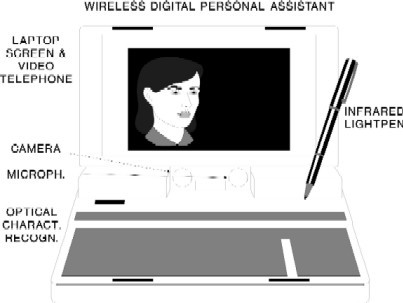You are here
General Information
| A Wireless Communications Perspective |
Since the end of the last century, when Marconi and Hertz demonstrated the feasibility of radio transmissions, mankind has endeavoured to fulfill the dream of flawless wireless multimedia telecommunications, enabling people to communicate with anyone, anywhere, at any time, using a range of multimedia services. In fact, "virtually" being with someone, anywhere, at any time at the push of a dialing key - provided that the wireless system, the communicator device as well as the human/communicator interface are up to the associated requirements - is a concept that ultimately leads to the impression of "tele-presence" while communicating.
Naturally, the provision of these "tele-presence" services requires a further quantum leap in a range of enabling technologies from the current state-of-the-art, which is constituted by the well-known mobile phone. The Communications Group is endeavouring to contribute in most of the associated areas. Our long-term research is focused on communications and information theory, providing ideas for more short-term applied research.

Figure 1 Wireless Multimedia Communicator
Hence it is anticipated that the near future will witness the integration of computation and communication in the form of highly intelligent shirt pocket sized multi-media communicators of the sort seen in Figure 1. We will be free from old-fashioned keyboards and mouses, as input devices, we will just talk to our computers. Again, some computers already run advanced speech recognition software, but this is just the commencement of an era hallmarked by a paradigm, which is also often referred to as mobile computing. This is, because our communicators are expected to be well endowed with computing power, memory and networking facilities, in order to serve business and, ultimately, personal users on the move. Some elements of this system - such as palm-top personal computers or personal mobile radio voice and data communicators - are already wide-spread, however, further research is required in order to amalgamate them into more ergonomic devices, improve the variety and quality of services offered and accommodate the increasing traffic requirements, while providing near-ubiquitous radio coverage at a low cost. The various propagation scenarios of indoor and outdoor wireless systems are also dramatically different, as illustrated in Figure 2, portraying the range of hostile outdoor macro-cells, the more benign micro-cells and the friendly - predominantly line-of-sight - wave-propagation scenario of indoor cells.

Figure 2 Various traffic cells
These indoor pico-cells are already in operation at virtually all railway stations, airports, filling stations, pedestrian precincts, however, they will soon permeate all offices, homes and even vehicles, such as trains, busses, aeroplanes, etc. In other words, some pico-cell base stations will be mobile themselves, providing higher quality radio coverage for users on a train, than the outdoor network, penetrating the train from high-rise macro-cellular base stations. A further advantage of such roaming base stations is that for example a bus will be always in the vicinity to provide radio coverage to surrounding cars and pedestrians, when in a traffic jam. This is the scenario where a large tele-traffic surge is observed, for example, due to a road traffic accident.

Figure 3 Frame 79 of "Football" sequence which illustrated minor decoding error at BER of 2.10-4 after convolutional decoding. The PSNR degradation observed is approximately 2 dB. The sequence was coded using rate 7/8 convolutional codes and transmitted using QPSK modulation.
The potential of having a wireless home network is also fascinating - though requiring substantial further research - allowing us to monitor all our domestic appliances remotely, while on the move. Indeed, it will be our own "body area network", which will do most of the monitoring and will draw the user's attention to problems only when requiring personal attention. In most scenarios the user's mobile agent will be capable of arranging directly for a service engineer to carry out the necessary maintenance job. The mobile agent will also be able to download the user's favourite sound track or video clip, after negotiating the best possible deal over the network. This then can be viewed on the user's multimedia communicator. The range of services available - once the imminent convergence of consumer electronics, computers and wireless communications took place - are limitless.
Only highly intelligent, near-instantaneously adaptive communicators are capable of carrying out the above complex functions and providing a seamlessly adjustable quality of service over the above mentioned wide range of propagation environments, user requirements, etc. More specifically, there is a plethora of challenges and contradictory factors, which impose conflicting criteria on the associated research. For these futuristic services to become attractive and affordable, they have to be offered near-ubiquitously, at low cost and high quality. However, "tele-presence-like" service quality requires a tremendous bandwidth for the transmission of full-motion video, for example. If this bandwidth requirement is multiplied by the ever increasing number of subscribers, only revolutionary new technologies will be capable of operating in the currently technologically unaccessible extremely high-frequency bands, where spectrum is still available for new services.
Multimedia signal compression is a powerful means of reducing the required bit rate of video signals, for example. However, again, there are a range of contradictory requirements, since increasing the compression ratio is only possible at the cost of increasing algorithmic and implementational complexity, which requires bulkier batteries. A further problem is - which is well-known for example in the context of zipped, i.e. highly compressed computer files - that a single bit error may corrupt an entire file, in this case a compressed video clip, as portrayed in Figure 3. Hence complex error correction techniques have to be invoked, in order to remove the associated transmission errors. It is this field, where the whole arsenal of signal processing has to be invoked, in other to cope with calamities imposed by the wireless communications channel.
All in all, a fascinating era for telecommunications researchers!
